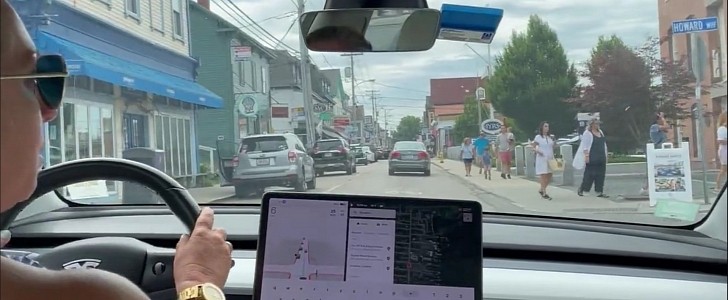Tesla continues to improve its Full Self-Driving software, although it sometimes seems like one step forward and two steps back. The latest iteration of the software, dubbed FSD Beta 10.69.2, smoothes out some rough edges and introduces new reasons to complain.
Tesla deployed the third phase of the 10.69 version of FSD Beta over the weekend, and feedback started to clog social media channels almost immediately. Probably wanting to avert criticism for not appropriately reacting to pedestrians, Tesla turned the dials to the max in this regard. Elon Musk announced that the software has become “overly cautious, especially around pedestrians.” This was confirmed by several reports by people who had already tested the software.
The rollout was delayed because the development team caught a bug at the last moment. The problem, which caused an 8% delay in detecting pedestrians, is said to have been fixed. Elon Musk confirmed the bug was new because pedestrian detection worked “super-human style” in 10.69.1.1. After the bug was squashed, it turns out that the Tesla FSD has become way more cautious around vulnerable road users.
Going from 10.69.1.1 to 10.69.2 seems like a tiny step, but the release notes paint a different picture. Tesla added a new “deep lane guidance” module to the vector lanes neural network. This fuses features extracted from the video streams with course map data like lane counts and lane connectivity. The change allows for a 44% lower error rate on lane topometry, enabling smoother control before lane selection.
The software further improves handling of tricky unprotected left turns, including optimizing how cars creep forward to better mimic human behavior. On the other hand, it might become an annoyance around pedestrians, sometimes slamming the brakes unnecessarily. A video posted by Tesla beta-tester Kim Paquette shows that the system would brake for people on the sidewalk with no intention to cross. Judging people’s intentions is hard to crack, even for humans.
The rollout was delayed because the development team caught a bug at the last moment. The problem, which caused an 8% delay in detecting pedestrians, is said to have been fixed. Elon Musk confirmed the bug was new because pedestrian detection worked “super-human style” in 10.69.1.1. After the bug was squashed, it turns out that the Tesla FSD has become way more cautious around vulnerable road users.
Going from 10.69.1.1 to 10.69.2 seems like a tiny step, but the release notes paint a different picture. Tesla added a new “deep lane guidance” module to the vector lanes neural network. This fuses features extracted from the video streams with course map data like lane counts and lane connectivity. The change allows for a 44% lower error rate on lane topometry, enabling smoother control before lane selection.
The software further improves handling of tricky unprotected left turns, including optimizing how cars creep forward to better mimic human behavior. On the other hand, it might become an annoyance around pedestrians, sometimes slamming the brakes unnecessarily. A video posted by Tesla beta-tester Kim Paquette shows that the system would brake for people on the sidewalk with no intention to cross. Judging people’s intentions is hard to crack, even for humans.
FSD Beta 10.69.2 rolling out now. Please note that top priority is safety, so expect it to be overly cautious, especially around pedestrians.
— Elon Musk (@elonmusk) September 11, 2022
#FSDBeta 10.69.2 is really struggling around pedestrians - way over cautious for people just on sidewalk and not crossing. Many interventions. I’ve often wondered how the AI will judge a human’s intentions - are they just standing there, or intending to cross? #tesla @elonmusk pic.twitter.com/DJ5nhitimk
— Kim Paquette ???????? ???????? ???? (@kimpaquette) September 11, 2022







